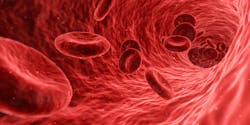Ushio has announced commercial availability of high-power short-wavelength infrared (SWIR) LEDs in the Epitex D-Series of components. The company says the new LEDs are as much as four times more powerful than the prior S-Series. Lower-power members of the D-Series feature surface-mount device (SMD) packaging commonly used in mid-power LEDs, whereas higher-power emitters can be supplied on surface-mountable ceramic substrates (the SMBB and EDC components) or in standard through-hole TO-66 packages.
While ultraviolet LEDs that radiate below the human visual range have been more prominent in the news of late due to germicidal properties, infrared (IR) LEDs that radiate above the human visual range also serve many life science applications. We have most often covered such LEDs that radiate in the 750–1000-nm range referred to as near infrared (NIR). For example, we recently covered the Osram Opto Semiconductor Piccolo LEDs designed for gesture recognition for driver control of automotive systems. That company has also supplied NIR LEDs for facial recognition and other applications.
The SWIR range, meanwhile, spans 900 or 1000 nm up to 1700 or even 2500 nm depending on who you ask. The range encompasses the region between visible and thermal imaging. SWIR LEDs are relatively more expensive than legacy sources such as halogen, but the LED sources offer the typical semiconductor benefits of less heat, smaller size, and lower power consumption.
The typical applications for SWIR LEDs involve the transmission of SWIR emission through various materials. For example, silicon material is transparent to SWIR energy; therefore, such sources can be used in semiconductor wafer inspection. The LEDs can be embedded in SWIR cameras and other inspection systems. An SWIR system, for example, can detect the fill level of a material being delivered into a plastic bottle. The components can simulate the sun. And medical uses range from spectroscopy to retinal scans to blood analysis. Another popular application is night vision products. In such security applications, SWIR beams pass right through rain, fog, and snow.
Capturing market with SWIR LED technology has been a difficult challenge due to the diverse set of applications and the requirements of each. Ushio, for example, offers components at more than 60 standard wavelengths. Moreover, component cost and power output remain a challenge. But the Ushio D-Series will expand the market for SWIR LEDs.
Across the D-Series, Ushio has doubled performance in terms of output power. And some of the high-power models can now be driven at 1A, thereby achieving the aforementioned four times improvement over earlier components. The LEDs generate 700 mW of radiometric power at 1A. The Epitex D-Series line also includes multi-emitter models to further extend output power in a discrete semiconductor package, just as some mid- and high-power visible-light LEDs integrate multiple emitters.
Ushio manufactures most of the D-Series on InGaAsP (indium gallium arsenide phosphide) wafers. The highest-power products are manufactured on GaAs (gallium arsenide) wafers. Ushio first invested in the former Epitex Inc to gain access to SWIR technology more than a decade ago. Ushio ultimately acquired Epitex in full and in April of this year fully integrated Epitex into its operations.
Coincidentally, Ushio is also a major player in the UV space. It’s Ushio that is behind the so-called far UV, 222-nm UV-C-band lamps that are said to be able to deactivate pathogens such as the coronavirus and that do not damage human skin or eyes — although such claims are still under study. That technology has even attracted the attention of general lighting manufacturers. For example, Acuity Brands and Ushio recently signed a partnership agreement.
For up-to-the-minute LED and SSL updates, why not follow us on Twitter? You’ll find curated content and commentary, as well as information on industry events, webcasts, and surveys on our LinkedIn Company Page and our Facebook page.






